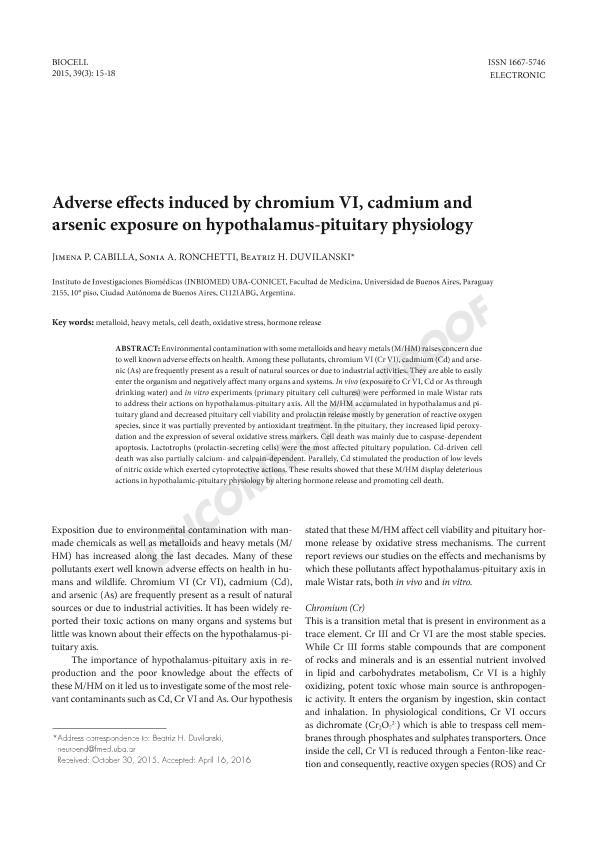Mostrar el registro sencillo del ítem
dc.contributor.author
Cabilla, Jimena Paula

dc.contributor.author
Ronchetti, Sonia Alejandra

dc.contributor.author
Duvilanski, Beatriz Haydee

dc.date.available
2018-06-12T14:58:50Z
dc.date.issued
2016-04
dc.identifier.citation
Cabilla, Jimena Paula; Ronchetti, Sonia Alejandra; Duvilanski, Beatriz Haydee; Adverse effects induced by chromium VI, cadmium and arsenic exposure on hypothalamus-pituitary physiology; Instituto de Histología y Embriología Dr. Mario H. Burgos (IHEM-CONICET); Biocell; 39; 4-2016; 15-18
dc.identifier.issn
1667-5746
dc.identifier.uri
http://hdl.handle.net/11336/48280
dc.description.abstract
Environmental contamination with some metalloids and heavy metals (M/HM) raises concern due to well known adverse effects on health. Among these pollutants, chromium VI (Cr VI), cadmium (Cd) and arsenic(As) are frequently present as a result of natural sources or due to industrial activities. They are able to easily enter the organism and negatively affect many organs and systems. In vivo (exposure to Cr VI, Cd or As through drinking water) and in vitro experiments (primary pituitary cell cultures) were performed in male Wistar rats to address their actions on hypothalamus-pituitary axis. All the M/HM accumulated in hypothalamus and pituitary gland and decreased pituitary cell viability and prolactin release mostly by generation of reactive oxygen species, since it was partially prevented by antioxidant treatment. In the pituitary, they increased lipid peroxydation and the expression of several oxidative stress markers. Cell death was mainly due to caspase-dependentapoptosis. Lactotrophs (prolactin-secreting cells) were the most affected pituitary population. Cd-driven cell death was also partially calcium- and calpain-dependent. Parallely, Cd stimulated the production of low levels of nitric oxide which exerted cytoprotective actions. These results showed that these M/HM display deleterious actions in hypothalamic-pituitary physiology by altering hormone release and promoting cell death.
dc.format
application/pdf
dc.language.iso
eng
dc.publisher
Instituto de Histología y Embriología Dr. Mario H. Burgos (IHEM-CONICET)
dc.rights
info:eu-repo/semantics/openAccess
dc.rights.uri
https://creativecommons.org/licenses/by-nc-sa/2.5/ar/
dc.subject
Metalloid
dc.subject
Heavy Metals
dc.subject
Cell Death
dc.subject
Oxidative Stress
dc.subject
Hormone Release
dc.subject.classification
Toxicología

dc.subject.classification
Medicina Básica

dc.subject.classification
CIENCIAS MÉDICAS Y DE LA SALUD

dc.title
Adverse effects induced by chromium VI, cadmium and arsenic exposure on hypothalamus-pituitary physiology
dc.type
info:eu-repo/semantics/article
dc.type
info:ar-repo/semantics/artículo
dc.type
info:eu-repo/semantics/publishedVersion
dc.date.updated
2018-06-06T13:38:33Z
dc.journal.volume
39
dc.journal.pagination
15-18
dc.journal.pais
Argentina

dc.description.fil
Fil: Cabilla, Jimena Paula. Consejo Nacional de Investigaciones Científicas y Técnicas. Oficina de Coordinación Administrativa Houssay. Instituto de Investigaciones Biomédicas. Universidad de Buenos Aires. Facultad de Medicina. Instituto de Investigaciones Biomédicas; Argentina
dc.description.fil
Fil: Ronchetti, Sonia Alejandra. Consejo Nacional de Investigaciones Científicas y Técnicas. Oficina de Coordinación Administrativa Houssay. Instituto de Investigaciones Biomédicas. Universidad de Buenos Aires. Facultad de Medicina. Instituto de Investigaciones Biomédicas; Argentina
dc.description.fil
Fil: Duvilanski, Beatriz Haydee. Consejo Nacional de Investigaciones Científicas y Técnicas. Oficina de Coordinación Administrativa Houssay. Instituto de Investigaciones Biomédicas. Universidad de Buenos Aires. Facultad de Medicina. Instituto de Investigaciones Biomédicas; Argentina
dc.journal.title
Biocell
dc.relation.alternativeid
info:eu-repo/semantics/altIdentifier/url/https://www.semanticscholar.org/paper/Adverse-effects-induced-by-chromium-VI%2C-cadmium-and-Duvilanski-Cabilla/0aaecb251b771cc9b4f7022923b63f0f59b52fa2
Archivos asociados
